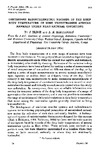| dc.contributor.author | Bligh, J | |
| dc.contributor.author | Harthoorn, AM | |
| dc.date.accessioned | 2015-11-12T11:02:08Z | |
| dc.date.available | 2015-11-12T11:02:08Z | |
| dc.date.issued | 1965 | |
| dc.identifier.citation | Bligh, J., & Harthoorn, A. M. (1965). Continuous radiotelemetric records of the deep body temperature of some unrestrained African mammals under near‐natural conditions. The Journal of physiology, 176(1), 145-162. | en_US |
| dc.identifier.uri | http://onlinelibrary.wiley.com/doi/10.1113/jphysiol.1965.sp007541/epdf | |
| dc.identifier.uri | http://hdl.handle.net/11295/92429 | |
| dc.description.abstract | The deep body temperatures of a wide range of animals have been
recorded in the literature. The majority of these records has depended upon
discrete measurements made while the animal was captive and restrained,
or immediately after death by shooting. Estimates of the variation in deep
body temperature have been achieved by making a series of measurements
of rectal temperature of one animal at different times of the day, or by
making a series of single measurements on several animals immediately
upon captivity or sudden death at different times of the day. Until
recently it has been impracticable to make continuous measurements of
the deep body temperature of unrestrained mammals in a natural or nearnatural
environment and virtually no such records existed when this study
was undertaken. In consequence, there was no reliable information concerning
the temporal pattern of the deep body temperature of a range of
mammals under these circumstances, and it was not possible to determine
the range of nychthemeral (24 hourly) variations in deep body temperature
that occur among the mammalian species generally described as being
homoeothermic.
The development of miniature recorder systems and radiotelemetric
systems for monitoring physiological parameters of unrestrained animals
now makes the collection of such data technically feasible. A batteryoperated
system of radiotelemetric thermometry designed for this purpose
(Bligh & Robinson, 1963; Robinson, 1964) has been used to make a series
of continuous 24-48 hr records of the deep body temperatures of several
mammalian species in East Africa. These animals were confined in a
paddock area, but were otherwise unrestrained at a location where they
occur, or have occurred, naturally or where they are customarily
husbanded. | en_US |
| dc.language.iso | en | en_US |
| dc.publisher | University of Nairobi | en_US |
| dc.title | Continuous radiotelemetric records of the deep body temperature of some unrestrained African mammals under near‐natural conditions | en_US |
| dc.type | Article | en_US |
| dc.type.material | en_US | en_US |

